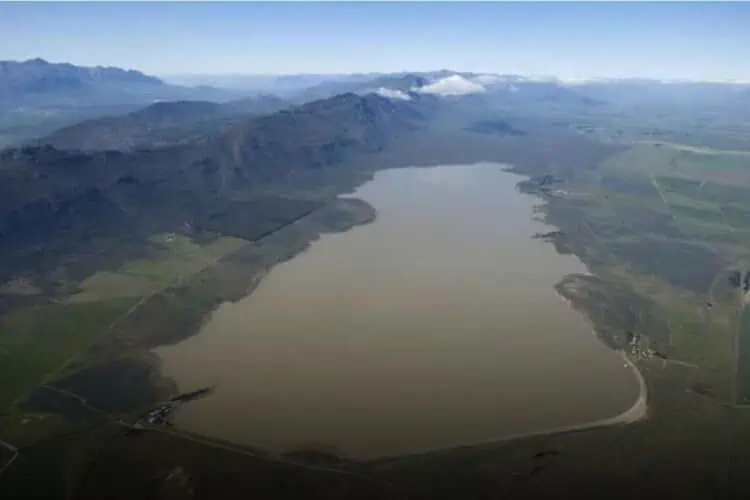As of Monday, 6 May 2024, Cape Town dam levels have decreased to 62.0%, showing a decline of 1.0% from the previous week.
This ongoing reduction shows the region’s struggle with drought conditions, despite early winter rains that have not significantly alleviated the water scarcity.
Cape Town dam levels drop to 62.0% on Monday, 6 May 2024
The major dams, including Berg River, Steenbras Lower and Upper, Theewaterskloof, Voëlvlei, and Wemmershoek, all reported declines in storage levels this week.
Notably, Berg River saw a decrease from 72.3% to 71.4%, and Theewaterskloof fell from 62.5% to 61.4%. The most significant reductions were seen in Steenbras Lower, which dropped from 59.2% to 57.9%.
Rainfall remains critically low with minimal amounts recorded across the region.
Notable readings include Newlands and Steenbras, which received 11.2 mm and 3.1 mm respectively, insufficient to make a significant impact on dam levels.
The lack of substantial rainfall continues to exacerbate the water scarcity, underscoring the need for stringent water conservation measures.
A look at changes in major dams
Here’s a look at the major Cape Town dam levels as of Monday, 6 May 2024:
| Dam | Capacity (ML) | Storage % on 6 May 2024 | Storage % Previous Week | % Change |
|---|---|---|---|---|
| Berg River | 130,010 | 71.4% | 72.3% | -0.9% |
| Steenbras Lower | 33,517 | 57.9% | 59.2% | -1.3% |
| Steenbras Upper | 31,767 | 80.0% | 80.1% | -0.1% |
| Theewaterskloof | 480,188 | 61.4% | 62.5% | -1.1% |
| Voëlvlei | 164,095 | 52.1% | 52.9% | -0.8% |
| Wemmershoek | 58,644 | 65.6% | 66.7% | -1.1% |
Cape Town minor dams weekly changes
Minor dams also experienced a reduction in water levels, decreasing overall from 40.6% to 39.1%. Among these, Woodhead saw a sharp decline from 37.7% to 32.2%, and Lewis Gay decreased from 48.8% to 43.6%.
These changes indicate a widespread impact across various water sources in the region.
| Dam | Capacity (ML) | Storage % on 6 May 2024 | Storage % Previous Week | % Change |
|---|---|---|---|---|
| Alexandra | 126 | 34.2% | 34.7% | -0.5% |
| De Villiers | 243 | 80.1% | 79.8% | +0.3% |
| Hely-Hutchinson | 925 | 0.0% | 0.0% | 0.0% |
| Kleinplaats | 1,368 | 40.6% | 41.2% | -0.6% |
| Land-en-Zeezicht | 451 | 99.4% | 99.4% | 0.0% |
| Lewis Gay | 182 | 43.6% | 48.8% | -5.2% |
| Victoria | 128 | 70.4% | 70.4% | 0.0% |
| Woodhead | 954 | 32.2% | 37.7% | -5.5% |
Five easy ways to save water and reduce consumption
Here are five effective ways to achieve this goal:
- Fix Leaks Promptly: A small drip from a leaking faucet or pipe can waste a significant amount of water over time. Regularly checking for and repairing leaks in plumbing fixtures, irrigation systems, and pipes can prevent water wastage.
- Install Water-Efficient Fixtures: Using low-flow showerheads, faucets, and toilets can significantly reduce water usage. These fixtures are designed to use less water while maintaining efficiency, which can lead to considerable savings on water bills and a substantial reduction in water consumption.
- Practice Efficient Watering: Watering lawns and gardens can consume a large amount of water. Watering during the early morning or late evening reduces evaporation and ensures that plants receive the moisture they need. Employing drip irrigation systems and soaker hoses targets water directly to the roots where it’s most needed, reducing waste.
- Use Water-Saving Appliances: Choosing appliances like dishwashers and washing machines that are energy and water-efficient can lead to substantial water savings. These appliances are designed to use minimal water while delivering optimal performance. Running them only when full maximizes efficiency and conserves water.
- Adopt Water-Saving Habits: Simple daily actions can lead to significant water savings. Turning off the tap while brushing teeth, shaving, or washing dishes by hand, and taking shorter showers are practical habits that reduce water use. Additionally, collecting rainwater for garden irrigation and using a broom instead of a hose to clean driveways and sidewalks can further decrease water consumption.






